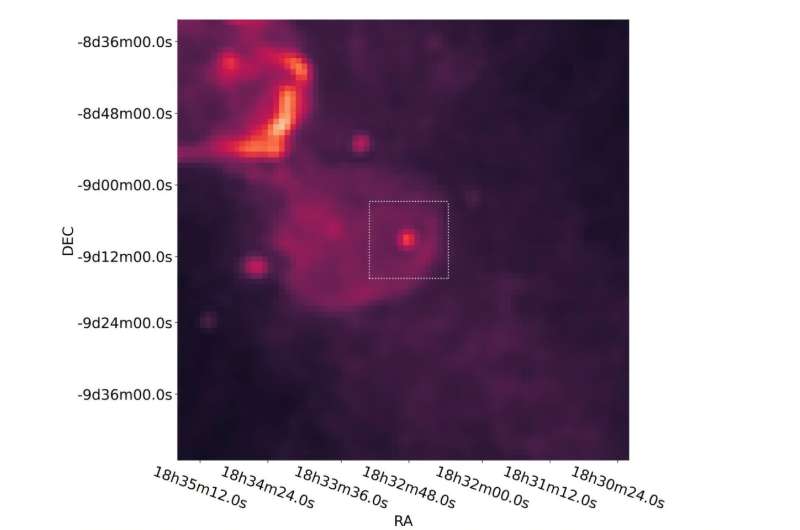
Observations detect a new long-period radio transient associated with supernova remnant G22.7-0.2 (Image Credit: Phys.org)

Using the DAocheng Radio Telescope (DART), Chinese astronomers have detected a long-period transient event. The newfound transient, which received designation DART J1832-0911, has a period of approximately 44 minutes and is associated with a supernova remnant known as G22.7-0.2. The finding was reported Nov. 24 on the pre-print server arXiv.
The so-called long-period radio transients (LPTs) are a new class of periodic radio emitters, with ultralong rotation periods (ranging from minutes to hours) and strong magnetic fields. Although some studies have suggested that LPTs may originate from rotating neutron stars with extremely strong magnetic fields (magnetars) or magnetic white dwarfs, their true nature is still debated.
To date, only eight LPTs have been identified, and now, a team of astronomers led by Di Li of Tsinghua University in Beijing, China, reports the detection of the ninth transient of this type. By conducting interferometric imaging with DART, across a frequency range of 149–459 MHz, they found an LPT within the projected region of supernova remnant (SNR) G22.7–0.2.
According to the paper, DART J1832-0911 has a spin period of 44.27 minutes and dispersion measure of about 480 pc/cm3. The recorded pulses of this LPT showed an estimated peak flux density between 0.5–2 Jy. Afterward, the transient entered a long-period quiescent state.
The observations found that DART J1832-0911 displayed a range of emission characteristics during its active radio period. It underwent mode changes modulated by variations in pulse width and strength. These changes revealed its evolution from bright, wide pulses to weaker, narrower ones.
“In the wide-pulse mode, pulses are typically strong, with widths around 200–250 seconds, whereas in the narrow-pulse mode, the pulses are much weaker, with widths of roughly 40–100 seconds,” the paper reads.
Based on the dispersion measure, the astronomers calculated the distance to DART J1832-0911, which was estimated to be approximately 14,700 light years. This is consistent with the distance to G22.7-0.2, which indicates that the transient resides in the supernova remnant bubble. Therefore, this is the first evidence associating LPTs with SNRs.
Moreover, the study found that DART J1832-0911 showcases highly polarized emission. The astronomers explained that it displays either phase-locked circularly polarized emission or nearly 100 percent linear polarization in radio bands.
Trying to explain the origin of LPTs, the authors of the paper concluded that the discovery of DART J1832-0911 favors the neutron star scenario. They added that the spatial association between the newfound LPT and G22.7-0.2 indicates that it is likely the stellar remains of a supernova, specifically a neutron star, rather than a white dwarf.
More information:
Di Li et al, A 44-minute periodic radio transient in a supernova remnant, arXiv (2024). DOI: 10.48550/arxiv.2411.15739
Journal information:
arXiv
© 2024 Science X Network
Observations detect a new long-period radio transient associated with supernova remnant G22.7-0.2 (2024, December 3)
retrieved 4 December 2024
from https://phys.org/news/2024-12-period-radio-transient-supernova-remnant.html
part may be reproduced without the written permission. The content is provided for information purposes only.








